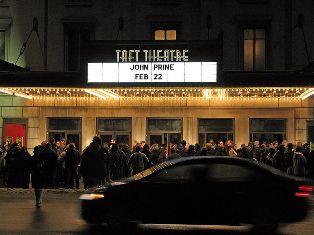
Move to Taft Theatre a Win-Win for Cincinnati and the Cincinnati Symphony Orchestra
Remember “Home for the Holidays?”

Lots of people in Cincinnati do (including the writer, who never missed it -- or missed writing about it each year).
For those who don’t remember, it was the Cincinnati Symphony
Orchestra’s Christmas show, held annually at the Taft Theatre on Fifth Street
downtown from 1996-2003. Created by
associate conductor John Morris Russell (now music director of the Windsor
Symphony in Windsor, Ontario), it was Cincinnati’s answer to New York's Radio City
Music Hall Christmas show. There were dancers, singers, actors, sets, costumes and production values unsurpassed among local holiday events (even the
Cincinnati Pops Holiday show at Music Hall, which paled by
comparison). Who will ever forget the "Porkopolis Penguins" or Russell reading "Yes, Virginia, there is a Santa Claus" timed to the millisecond to "Nimrod" from Edward Elgar's "Enigma Variations?"

With the announcement in September that the CSO and Pops (the CSO in red blazers) would move to the Taft Theatre during the 2012-2013 season – during the time Music Hall will be closed during the construction phase of its projected revitalization project -- it was a natural to ask Russell about the viability and wisdom of the move. With Russell in Cincinnati to open the Pops Music Hall season Sept. 24-26, it was timely, as well.
“What we were doing is a little bit different from what the
Symphony is going to be doing there,” said Russell, “because ‘Home for the
Holidays’ was largely an amplified show, and it was placed way upstage because
we had to have the fore stage for all the actors and dancers and things going
on.” To optimize acoustics, the CSO
is going to add a fore stage, he said, “to get the orchestral out into the
hall.
"The other thing they’re planning to do is to have an acoustical shell for the orchestra. From my experience working with orchestras in theaters as opposed to a concert hall, the shell and getting the sound past the proscenium arch is the most important thing."
The shape and size of the Taft (2,500 seats as opposed to 3,500 in Music Hall) are a definite plus, he said. “It reminds me of Orchestra Hall in Detroit. It’s got that rectangular shape and that high sloping balcony in the back. It’s made of the right materials -- big thick walls, great plasterwork. The bones are there, and I think with a solid acoustical shell and getting the orchestra out into the hall, it will be a really great sound.” (Orchestra Hall in Detroit, one of the finest concert halls in the U.S., seats 2,014 and is renowned for its acoustics, producing what Russell described as "a big, buttery sound in the strings.”)
Another plus for the Taft is the size of the stage -- smaller than Music Hall and more like Orchestra Hall in Detroit, Severance Hall in Cleveland and Carnegie Hall in New York, said Russell. “The orchestra is going to be packed in there. When you have less real estate for the orchestra and people are a little closer, it tends to make them play better together. One of the reasons why orchestras excel in those spaces is because they are packed really tightly together, and the fact that you’re tight makes the orchestra sound tight.”
The orchestra is “naturally going to have a little bit of trepidation” spending an entire season in the new space, said Russell, who served as CSO assistant/associate conductor from 1995-2006. “There are going to be some things that may not be the same -- not what people kind of expect because they’re so used to Music Hall -- but there are going to be some new and different things that are going to be better. It’s just having people go in there with an open mind.”
“Given the alternatives” -- such as a temporary venue in the suburbs or trying to utilize the Aronoff Center, which is designed for amplified shows and would need even more acoustical adjustment – “it’s really a great situation. After some updates and living in the theater for a year and being able to make it into a great venue, it really is a win-win situation.
“I was downtown visiting all of my favorite haunts, Fountain Square, a little ice cream and over to my favorite Skyline, which is the one right next to the stage door of the Taft. I talked to a couple of folks working there: ‘You know, the Symphony is going to be moving to the Taft Theater in a couple of years.’ They looked at me kind of funny, ‘Oh, really?’ ’You’re going to have to extend your hours and be ready. Your lunchtime crowd is going to be increased because the orchestra is going to be right there. You’ve got another 90-some people who are going to be in the neighborhood for lunch, and that’s good for business.’
“The proximity of the Taft to so many other restaurants and stores and shops and such will help revitalize that part of downtown,” said Russell. “It’s a real nifty part of town and look at its proximity to Procter and Gamble (right across the street). Wow, you might be able to start a light classics series right after work. The move to the Taft will be exciting because it will allow the orchestra to get up into the community and to do some concerts and programming that are more out of the box. It will develop a close relationship with the people who live in that area so that when they do move back to Music Hal, they’ll bring everyone back with them.”
The Taft also bids to become an income stream for the CSO. Under the terms of a multi-year lease agreement with the owner, The Scottish Rite of Freemasonry, the CSO’s Music and Event Management, Inc. will take over operations of the theater, effective immediately. MEMI is a non-profit, wholly owned subsidiary of the CSO. Incorporated in 2001, MEMI operates Riverbend Music Center (owned by the CSO), and has also managed Tall Stacks, the Cincy-Cinco Latino Festival and Jammin’ on Main. All of its net revenue benefits the CSO. As it has in the past, the Taft will continue to present a variety of entertainment events, including music, comedy and theater, and will remain home to the Children’s Theatre of Cincinnati.
Named for Charles Phelps Taft, the Taft Theatre was built in 1928 by the Scottish Rite Masons. The Scottish Rite of Freemasonry was organized in Cincinnati in 1853 and currently numbers over 8,000 members in the Greater Cincinnati area, where it sponsors a variety of philanthropic causes, including the Carl and Edyth Lindner 32nd Degree Masons Learning Center for Dyslexic Children.
“With Music Hall unavailable during the 2012-2013 season, we carefully considered a number of possible venues for the Orchestra and nothing measured up with what the Taft had to offer,” said CSO” president Trey Devey. “It will serve both our audience and performers well.”
Will “Home for the Holidays” return? One can only hope.